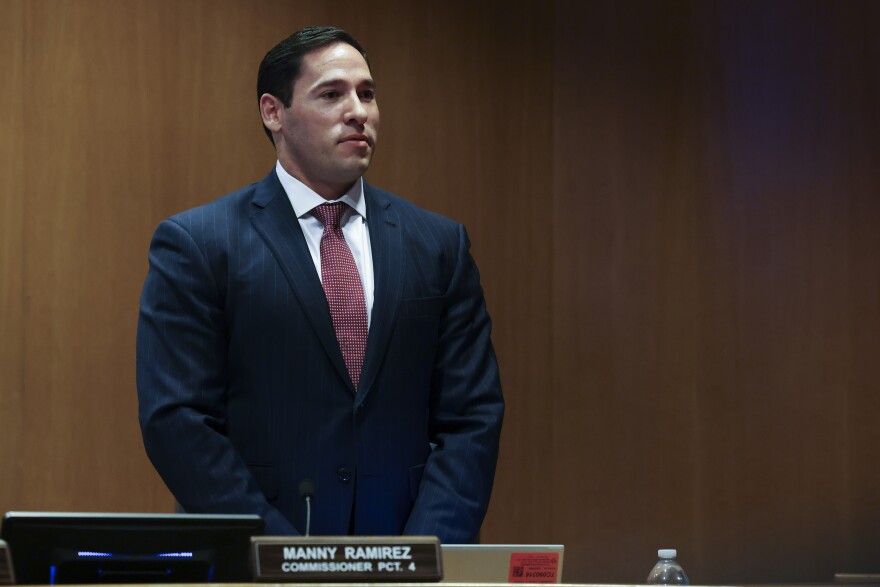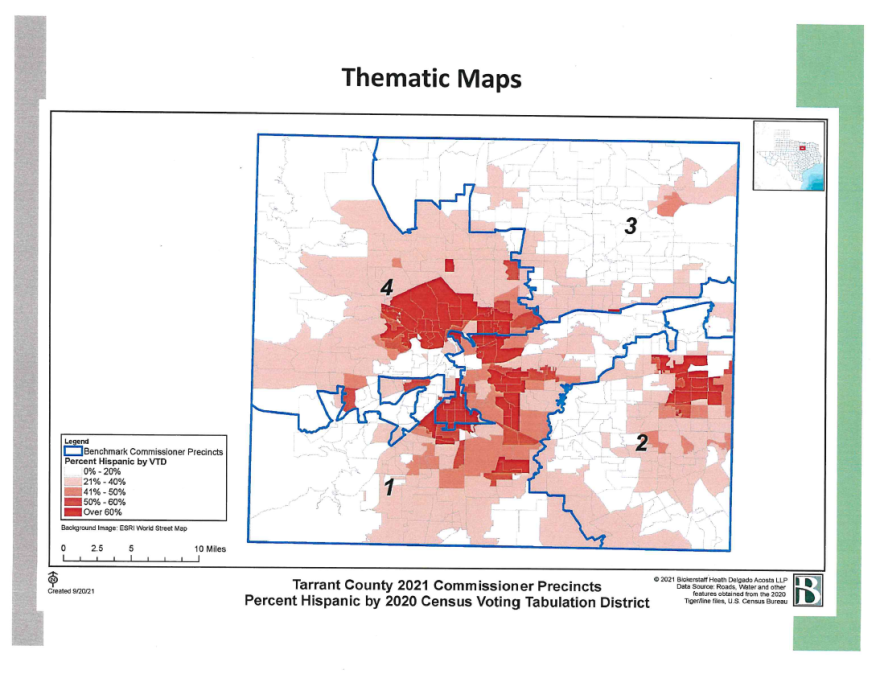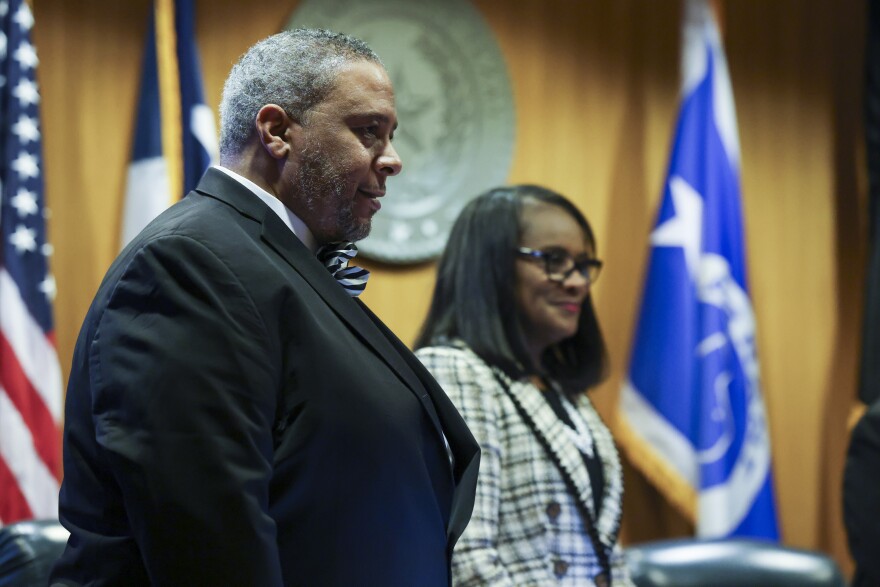Tarrant County is starting the redistricting process, and even before any new maps are drawn, Democrats are warning about lawsuits.
Tarrant County Republican commissioners recently outvoted the Democrats, 3-2, to hire a conservative law firm to reconsider the boundaries of the county commissioners precincts.
Democrats are accusing Republicans of trying to redraw Democratic County Commissioner Alisa Simmons’ Precinct 2 to make it harder for her to win reelection next year. Simmons represents Arlington, and her precinct flipped from Republican to Democrat in 2018.
Republican Commissioner Manny Ramirez, though, says redistricting must happen to make sure the four precincts are balanced by population.
Experts say redistricting is always a controversial — and deeply political — process. In Tarrant County, the rules that govern how maps can be drawn are about to get a lot of scrutiny.
Is redistricting mid-decade legal?
At the contentious commissioners court meeting where Republicans voted to start the redistricting process, Simmons wondered if that was even allowed. Redistricting usually happens after the U.S. Census every ten years.
"Tarrant County doesn't possess the authority to redraw the commissioners court map for the remainder of this decade,” she said.
In 2021, a different set of commissioners decided the precincts were in balance by population, and they left the map the same. Any new redistricting should happen in 2031, Simmons argued.

But experts told KERA News that the county is allowed to redistrict outside the usual schedule.
“A mid-decade redistricting, I would say, is unusual but not unprecedented," said Bob Heath, an attorney who helped draw Tarrant County’s maps for decades.
Heath has worked in redistricting for so long, he remembers when he did it with adding machines “and big maps that were spread out across the floor.” He’s a partner in Bickerstaff Heath Delgado Acosta, an Austin law firm that works with about 100 mostly local governments to redistrict when the Census rolls around, he said.
Redistricting is a notoriously political process that both parties take advantage of when they can, Heath said. When Republicans are in charge, they might want to put Democratic voters into heavily Democratic districts and give themselves majorities in others.
“And of course, if the Democrats are in charge, they’re going to do exactly the same thing from the opposite viewpoint,” he said.
University of Houston political science professor Brandon Rottinghaus agreed that mid-decade redistricting is allowed but controversial.
“People will look at this with a raised eyebrow, saying that this is partisan and politically motivated,” he said. “It's impossible to get away from those kinds of concerns.”
A county might need to redistrict mid-decade if the population between districts is becoming unbalanced, Rottinghaus said.

Former Tarrant County Judge Glen Whitley participated in several county redistrictings during his decades on the commissioners court, including the last one that left the map the same. The Republican said there’s no other reason to redistrict now except partisanship.
"I think quite honestly, there are those that felt like Precinct 2 could be drawn in such a way as to put it back in Republican hands,” Whitley said.
Are Tarrant County’s precincts unbalanced by population?
Population is part of the reason Republican County Commissioner Manny Ramirez voted in favor of starting the redistricting process. Tarrant County has grown considerably since the last time the map changed in 2011, he told KERA News.
“You can just intuitively look at it and say there's zero way that we're balanced," he said.
Tarrant County's precincts were well within the required population balance after the most recent census in 2020, data shows.
In September 2021, Heath gave a presentation to commissioners, breaking down the population in each precinct. Overall deviation between the ideal population count, and the biggest and smallest precincts’ actual populations, should be less than 10%, Heath said. After the 2020 Census, overall deviation was just under 2%.

"I don't recall the exact number for what it was when those districts were drawn in 2011, but it was higher than a 2% deviation,” Heath said.
The small deviation surprised commissioners. Tarrant County grew by 300,000 people between 2010 and 2020, according to U.S. Census data.
Heath told commissioners the county's rapid growth was spread across precincts.
“I was extremely surprised, and I told our people I want to double and triple check it," he said at the 2021 meeting.
Ramirez acknowledged he does not have current data to show the precincts are uneven.

Even a 2% deviation, in a county as big as Tarrant, is a lot, he said.
"I think we need to get as close to equally balanced by person as possible. I mean, if you could quite literally have even precincts to the number, I think that's how reapportionment should go," he said.
Ramirez also stressed that the process has just begun.
“The vote that we took on (April 2) was to examine and explore the idea," he said.
Why is Precinct 1 shaped like that?
Dozens of people attended the commissioners court meeting, to speak both for and against redistricting. One thing supporters of redistricting kept bringing up was the shape of Precinct 1, which has long been represented by a Democrat.
Precinct 1 covers southwest Tarrant County and stretches eastwards across Fort Worth, all the way to the other side of the county. Speakers said the precinct is gerrymandered in Democrats’ favor.
Precinct 1 Commissioner Roderick Miles Jr. said he didn’t know how his precinct got its shape – that was before his time. KERA News wasn't able to get in touch with his predecessor, Roy Charles Brooks.
The way Heath remembers it, Precinct 1 was shaped like that to preserve its status as a “largely, although not majority, African American district,” he said.


By Whitley’s recollection, at one time, Precinct 2 and Precinct 3 needed to shed some population. One way to do that was to give some of their land, in eastern Tarrant County, to Precinct 1.
Brooks also wanted his precinct to include Mosier Valley, south of Hurst-Euless-Bedford, Whitley said. That’s a historically Black community, founded as a freedmen’s town after the Civil War.
“Roy was more than glad to pick that up, and that relieved population from both Precinct 3 and Precinct 2,” Whitley said.
It's perfectly legal to take race into consideration when drawing districts, Rottinghaus said. It just can't be the only consideration.
What does a fair map look like?
The Voting Rights Act bans discrimination against racial or ethnic groups when drawing districts.
The most common forms of discrimination are called cracking and packing, Heath explained. Cracking is when someone takes a minority group that could dominate one district and spreads it out over several, diluting that group's political power.
Packing is the opposite. Instead of letting a group have electoral influence in two districts, it gets shoved into one, “so those votes are essentially wasted,” Heath said.
Simmons and other opponents to this mid-decade redistricting say it's an act of discrimination, designed to dilute the voting power of people of color in Tarrant County’s majority-minority districts, including her Precinct 2 and Miles’ Precinct 1.
According to the 2020 Census data, Ramirez's Precinct 4 is also majority-minority. Precinct 3 in northeast Tarrant County, represented by Republican Matt Krause, is the only precinct where non-Hispanic white people make up more than half the population.
A good map also strives to keep neighborhoods and historic voting blocs together, while balancing them by population, Heath said.
That’s why even though Tarrant County is shaped like a perfect little square, it can’t be split into four even slices, Rottinghaus said.
“Simplicity is always valued in mapmaking, but the problem is that sometimes you can't be as simple as you'd like, because you have to take into account certain kinds of factors about the individual communities," he said.
Everyone KERA News spoke to for this story said no matter what, the redistricting process is political.
Former Tarrant County commissioners openly acknowledged this in 2011, in a Fort Worth Star-Telegram article about the approval of a new preliminary map.
“In the southeast section of my precinct I primarily gave up more Democrats than Republicans, and that made me happy,” Republican Commissioner Gary Fickes said.

"Being pragmatic, I was looking to pick up minorities and Democrats,” Commissioner Roy Charles Brooks said. “And the rest were looking to maximize their interests as well — that's how the process works."
Partisan mapmaking is not unique to Tarrant County, Ramirez told KERA News.
When asked if he aims to make the map more friendly to Republicans, he said he believes conservative values are "what built Tarrant County into the place that it is today."
“I certainly am in favor of ensuring that that's the way we continue to lead," he said.
What happens next?
The timeline for the redistricting process is not clear. During the last redistricting process in 2021, the county held multiple public information sessions. Ramirez said he expects there to be "some form of that," but he's not certain.
The contract with the Public Interest Legal Foundation, the conservative law firm hired to do the work, did not lay out how long evaluating the current map might take.
Republican County Judge Tim O'Hare said at commissioners court the public would get a chance to look at any potential maps and comment on them. He’s the one who brought the redistricting agenda item forward. He did not respond to multiple requests for comment.
The specter of lawsuits is already haunting the process. Before the commissioners' vote, State Rep. Chris Turner, D-Grand Prairie, called mid-decade redistricting “a completely unnecessary, foolish endeavor that will undoubtedly expose Tarrant County taxpayers to costly litigation."
Rottinghaus said lawsuits are pretty much inevitable during redistricting.
"There's a 100% chance that this will end up in court. It almost always does,” he said. “When you've got a mid-cycle redistricting, it's certainly something that's going to raise a lot of red flags for people."
When map challengers have succeeded in court, it’s with minor changes to the map, Rottinghaus said. Getting an entire new map thrown out is rare.
Got a tip? Email Miranda Suarez at msuarez@kera.org.
KERA News is made possible through the generosity of our members. If you find this reporting valuable, consider making a tax-deductible gift today. Thank you.





